Black swans in Taiwan
In a dam at the center of Chung Cheng University in Taiwan, a pair of black swans were to be seen.


The Last European Barbarians: The Vikings
That was the title of my lecture today in Taiwan. I had a large powerpoint-presentation, introduced some ideas from my book, and told them about Roberta's conclusions concerning the blood eagle. The audience seemed to like it.

(Not sure about the professor of English-bit. In all the other materials, I was correctly identified, including the slide they showed just before this one).

(Not sure about the professor of English-bit. In all the other materials, I was correctly identified, including the slide they showed just before this one).
Arrived in Taiwan
I have arrived in Taiwan. I was met at the airport by a graduate student, who put us (a professor from PKU was on the same flight) in a taxi. This took us to the railway station, where we waited for colleagues from Korea. When everyone was there we took the train from Taiyuan to Chiayi. This was the new bullet train of Taiwan, which goes in an absolutely straight line. The highest speed announced was 290 km/h. And the ride was smoother than just about any train ride I have been on. Very impressive.l
Amazing staff at the conference. Amazing campus; this is a relatively new university, only 21 years old (this weekend, as a matter of fact!). Very spacious and nice hotel room. Cocktail party and then dinner, from which the picture below comes.

Amazing staff at the conference. Amazing campus; this is a relatively new university, only 21 years old (this weekend, as a matter of fact!). Very spacious and nice hotel room. Cocktail party and then dinner, from which the picture below comes.

Oseberg
Today I am going to talk about the Oseberg burial, among other things, in my lecture. So I thought I should share some pictures from when I visited the museum in May.


The Oseberg women, who were buried in this magnificent grave.



The Oseberg women, who were buried in this magnificent grave.

Sima Qian
On Saturday, I met with Hong again, who kindly helped me navigate some bookstores, looking now for a nice edition of the Yuan shi. One campus, there were second-hand bookdealers who had spread out their wares on tables. I found a volume from the so-called Grand historian, Sima Qian, nicely printed and bound. It is printed in traditional characters, and I think the layout of each page is rather beautiful. It is only one volume of the work, but that should suffice for the time being, considering that I cannot read it.
Afterwards, we had dinner at a restaurant that specializes in tofu. It was good.



Afterwards, we had dinner at a restaurant that specializes in tofu. It was good.



Skype with my kids
Sunday, I spoke with my children on skype. They were, as always in a good mood.

Elsa's panda is cool in his shades.

As is Elsa.


Elsa's panda is cool in his shades.

As is Elsa.

Visit to Prince Gong's Mansion
This Friday, the Yale program made an excursion to Prince Gong's Mansion in central Beijing. This is a preserved Qing-dynasty princely residence which is about as close as one can get today to the mansions described in the famous novel Dream of Red Mansions. My colleague Tina Lu teaches a course on this novel, so her students were also welcomed to the excursion. It was a very pleasant excursion; we were allowed to stroll freely, without a guide. I lost track of the group when I wanted to make some photographs, but I later ran into Ningping.
I just had to photograph the library. There is a very unique document inside it, but we were not allowed to go inside to look at it, but I glimpsed the monter. Not sure exactly what the document is.

Me at one of the gates in the compound. The mansion consists of a sequence of courtyards with buildings around it, followed by a large garden.

I saw this kind of stone, from Taihu lake, Jiangsu province, in Southern China, in several of the courtyards. Such stones are thought to be very beautiful.

The main gate to the garden is built as an imitation of the westernizing style of the architecture that the Jesuits helped produce for the emperor's Old Summer Palace.

A manmade lake in the garden. Must be really nice and cool around it in the summer.

A dramatic walkway among rocks in the garden. Are such things also imitation of westernizing gardens that I suppose the Jesuits might have helped produce?

The lake had colonies of ducks.

This is an authentic Peking Duck.

Our director Ningping.

Sorry, this is me again.

Outside the mansion, the rickshaw drivers were looking for fares. I rode a real rickshaw (meaning that also locals used them for errands) when I visited Yogyakarta in 1990, so I did not feel the need to try one.

I just had to photograph the library. There is a very unique document inside it, but we were not allowed to go inside to look at it, but I glimpsed the monter. Not sure exactly what the document is.

Me at one of the gates in the compound. The mansion consists of a sequence of courtyards with buildings around it, followed by a large garden.

I saw this kind of stone, from Taihu lake, Jiangsu province, in Southern China, in several of the courtyards. Such stones are thought to be very beautiful.

The main gate to the garden is built as an imitation of the westernizing style of the architecture that the Jesuits helped produce for the emperor's Old Summer Palace.

A manmade lake in the garden. Must be really nice and cool around it in the summer.

A dramatic walkway among rocks in the garden. Are such things also imitation of westernizing gardens that I suppose the Jesuits might have helped produce?

The lake had colonies of ducks.

This is an authentic Peking Duck.

Our director Ningping.

Sorry, this is me again.

Outside the mansion, the rickshaw drivers were looking for fares. I rode a real rickshaw (meaning that also locals used them for errands) when I visited Yogyakarta in 1990, so I did not feel the need to try one.

The Moor in Beijing
Shakespeare performances are coming to the Great Hall of Peking University, as announced by giant posters.


Autumn has begun In Beijing
Autumn has most definitely started here in Beijing. It has been chilly the last few days both outside and inside. Apparently, our supposedly international and luxurious hotel/community follows the old-fashioned inflexible Chinese rule of not turning on the heat until a specific date, the specific weather be damned. So I am sitting here, fully dressed, with bathrobe and all, trying to write in 16 degrees Celsius, which is not really easy.
Today, for the first time since arriving, I took out my winter jacket and hat. I guess it is time to pack my summer clothes into a box and send them back to New Haven. Just last Wednesday, I was sitting outside my classroom reading in pleasant temperatures before class. This week, I read inside.

Today, for the first time since arriving, I took out my winter jacket and hat. I guess it is time to pack my summer clothes into a box and send them back to New Haven. Just last Wednesday, I was sitting outside my classroom reading in pleasant temperatures before class. This week, I read inside.

Poor Hjalmar is ill
Poor Hjalmar has a strep infection. We were chatting on Skype on Sunday, while his mother was fetching Elsa from a party. But Hjalmar seemed happy, especially when he got to play and talk about his Nintendo DS.


Dinner with colleague
On Saturday, I had dinner with my program colleague Ms. Hong, who is one of our Chinese teachers. We talked about graduate school, history, and Chinese. I am curious to know how hard it is to learn enough characters to be able to read in the dynastic histories of China. Well, there are twenty-four of them, which together make up a large work in many huge volumes. But I mean to read just a little, for example in the 元史(Yuan shi), the official Ming-era history of the Mongol Yuan dynasty. Just another of my hare-brained ideas that is going nowhere. But I would not have to learn much more than a thousand characters, which strike me as potentially possible. Then, of course, there is a great risk that the lapidary formulations of classical Chinese will make no sense even if one knows a thousand characters.
In any case, Ms. Hong is good to talk with about such things, for she spent last academic year teaching Chinese at the great sinological center at Leiden University, Holland, where people work really seriously with the ancient Chinese texts.
Funny detail: we were chatting about this in the bus back from the Wall on Friday, of course sitting down. When we got out of the bus, she looked up at me and said words to the effect of: Gosh, you are tall.

This is me on Saturday.

In any case, Ms. Hong is good to talk with about such things, for she spent last academic year teaching Chinese at the great sinological center at Leiden University, Holland, where people work really seriously with the ancient Chinese texts.
Funny detail: we were chatting about this in the bus back from the Wall on Friday, of course sitting down. When we got out of the bus, she looked up at me and said words to the effect of: Gosh, you are tall.

This is me on Saturday.

Chinese tutoring
Since the semester started, I have continued my lessons in Chinese (every Thursday), now with a new teacher, Ms. Cui. She is very good and very patient.

This is how ruffled I look after two hours of Chinese. We have the lessons in my university office.

I am very happy for the little Chinese that I have both learnt and managed to remember (I have learnt and forgotten a lot). If one keeps out of the expat and tourist ghettos, people like restaurant waiters, shop keepers, and subway cashiers know very little English, if any, and I would have had considerable difficulties had I not been able to order food or ask for the wonderful xiao bin (like flat pirogues with boiled cabbage inside) at the minuscular local bakery.

This is how ruffled I look after two hours of Chinese. We have the lessons in my university office.

I am very happy for the little Chinese that I have both learnt and managed to remember (I have learnt and forgotten a lot). If one keeps out of the expat and tourist ghettos, people like restaurant waiters, shop keepers, and subway cashiers know very little English, if any, and I would have had considerable difficulties had I not been able to order food or ask for the wonderful xiao bin (like flat pirogues with boiled cabbage inside) at the minuscular local bakery.
Lecture about the great walls of China
Before we went to the Great Wall at Jinshanling, the PKU-Yale program had invited an enthusiast for the wall to show us his photos of it and talk about it. He spoke Chinese in Ningping interpreted ably. I thought it was a good lecture; he clearly knows history and he has travelled with his companion far and wide to photograph various sections of the wall. It was very interesting.
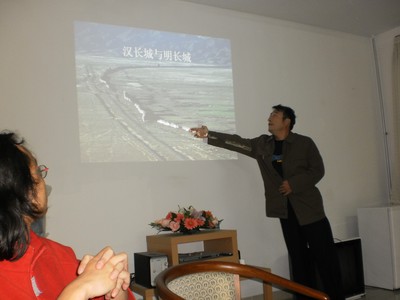
The same day, I finished reading the brilliant Paolo Squatriti's article "Digging Ditches in Early Medieval Europe" (Past and Present 2002). He argues with great conviction and drawing on the work of, among others, my colleague Jim Scott, that undertakings such as Offa's Dyke in Western England and the Danevirke in Southern Denmark had no practical value. He argues that rulers had these things constructed simply in order to show that they could, in other words, to demonstrate their power over the population, especially in marginal and newly conquered areas. Charlemagne's attempt at a canal between the rivers Main and Danube (well, stricly speaking their tributaries) is his most persuasive example: the undertaking was impossible, and it should have been obvious to Charlemagne that it was impossible, but he had recently conquered the surrounding area and needed to show that he was powerful. He does not seriously address the Great Wall of China, but he does say that the same reasoning applies to it (and refers to a book by Arthur Waldron that I must read). I really like the article, but I cannot help to think that it is not telling the entire story. While it is true that the Danish kings never could have had enough soldiers to man the Danevirke to make it into an efficient defense fortification, the same surely does not apply to the emperor of China, who could draw on a huge army. Also, Hadrian's wall in Northern England (which, curiously Squatriti does not mention, except once in passing) obviously was garrissoned with soldiers; there is sufficient archeological evidence for that, which I saw when I lived in Newcastle and visited the University museum. I need to think more about this, but I have a feeling that there is a part of the story that still escapes us.

The same day, I finished reading the brilliant Paolo Squatriti's article "Digging Ditches in Early Medieval Europe" (Past and Present 2002). He argues with great conviction and drawing on the work of, among others, my colleague Jim Scott, that undertakings such as Offa's Dyke in Western England and the Danevirke in Southern Denmark had no practical value. He argues that rulers had these things constructed simply in order to show that they could, in other words, to demonstrate their power over the population, especially in marginal and newly conquered areas. Charlemagne's attempt at a canal between the rivers Main and Danube (well, stricly speaking their tributaries) is his most persuasive example: the undertaking was impossible, and it should have been obvious to Charlemagne that it was impossible, but he had recently conquered the surrounding area and needed to show that he was powerful. He does not seriously address the Great Wall of China, but he does say that the same reasoning applies to it (and refers to a book by Arthur Waldron that I must read). I really like the article, but I cannot help to think that it is not telling the entire story. While it is true that the Danish kings never could have had enough soldiers to man the Danevirke to make it into an efficient defense fortification, the same surely does not apply to the emperor of China, who could draw on a huge army. Also, Hadrian's wall in Northern England (which, curiously Squatriti does not mention, except once in passing) obviously was garrissoned with soldiers; there is sufficient archeological evidence for that, which I saw when I lived in Newcastle and visited the University museum. I need to think more about this, but I have a feeling that there is a part of the story that still escapes us.
The Great Wall at Jinshanling
The Yale-PKU program organized an excursion to the Great Wall today. We visited the wall at Jinshanling, some 130 kilometers of easy road from Beijing.
Like at Mutianyu, there was a cable car up to the top of the ridge where the wall is. This time the cars were small and they wobbled disconcertingly in the wind. I sat very still.

I thought the wall was particularly gorgeous in Jinshanling. The first picture is from a window in one of the watch towers.



I was happy to see that one did not have to walk far from the cable car to get to sections of the wall that have not been renovated. China seems to renovate its historical relics with a heavy hand (rather like Viollet-le-Duc, as I have said before), so it is very good to be able to see what the wall looks like without such interventions.

One has to be careful climbing unrenovated stairs.


At the watch tower where I, alas, had to turn back to rendez-vous with the rest of the Yale group (for this was an official PKU-Yale program excursion) I met four very nice Europeans: a Dutch couple and two women from Norway (one of which has even studied medieval history at Oslo university!). We chatted for a while, which was so pleasant that I (for once) was the last person back to the bus (but only one minute after the other dalliers). I gave them the address to the blog, so I hope they read this and comment. If you like larger files of the photos, I am happy to send them! And I would like to have the photos you took of the group! I also hope they come to visit Peking University (subway line 4: East Gate of Peking University).

This is the local woman who took the photo above. As is apparently the tradition at Jinshanling, she attached herself to me as soon as I got off the cable car, and then she followed me everywhere I went. The idea was of course to sell me souvenirs at the end. It worked. At first I was somewhat irritated to have a local tail, who now and then would make a comment in any of the two dozen English phrases she had picked up. I even tried to outrun her in some of the steep parts of the wall, but she kept up admirably. On the way back, I thought that I can just as well take it as a language tutoring lesson, so I started to use my poor little Chinese on her. I found out that she lives in Hebei province, has been a farmer growing corn (but I am not sure what she means by that). She claimed to be 65 years old, considers herself Mongolian, and has 4 children. Two of whom are farmers and two study, but I did not know the word for what they are studying. She told me her name, but I am afraid I have forgotten it In the end, I got a somewhat expensive Chinese lesson, although my teacher threw in two T-shirts to sweeten the deal.'

Like at Mutianyu, there was a cable car up to the top of the ridge where the wall is. This time the cars were small and they wobbled disconcertingly in the wind. I sat very still.

I thought the wall was particularly gorgeous in Jinshanling. The first picture is from a window in one of the watch towers.



I was happy to see that one did not have to walk far from the cable car to get to sections of the wall that have not been renovated. China seems to renovate its historical relics with a heavy hand (rather like Viollet-le-Duc, as I have said before), so it is very good to be able to see what the wall looks like without such interventions.

One has to be careful climbing unrenovated stairs.


At the watch tower where I, alas, had to turn back to rendez-vous with the rest of the Yale group (for this was an official PKU-Yale program excursion) I met four very nice Europeans: a Dutch couple and two women from Norway (one of which has even studied medieval history at Oslo university!). We chatted for a while, which was so pleasant that I (for once) was the last person back to the bus (but only one minute after the other dalliers). I gave them the address to the blog, so I hope they read this and comment. If you like larger files of the photos, I am happy to send them! And I would like to have the photos you took of the group! I also hope they come to visit Peking University (subway line 4: East Gate of Peking University).

This is the local woman who took the photo above. As is apparently the tradition at Jinshanling, she attached herself to me as soon as I got off the cable car, and then she followed me everywhere I went. The idea was of course to sell me souvenirs at the end. It worked. At first I was somewhat irritated to have a local tail, who now and then would make a comment in any of the two dozen English phrases she had picked up. I even tried to outrun her in some of the steep parts of the wall, but she kept up admirably. On the way back, I thought that I can just as well take it as a language tutoring lesson, so I started to use my poor little Chinese on her. I found out that she lives in Hebei province, has been a farmer growing corn (but I am not sure what she means by that). She claimed to be 65 years old, considers herself Mongolian, and has 4 children. Two of whom are farmers and two study, but I did not know the word for what they are studying. She told me her name, but I am afraid I have forgotten it In the end, I got a somewhat expensive Chinese lesson, although my teacher threw in two T-shirts to sweeten the deal.'

Chinese Wisdom

They are right. It is very, very dangerous to speak or send text messages while driving.
Down jackets on last whole day in Beijing
On Saturday, we went to the local market to visit our tailors, who have made down jackets for all the Swedes (I got mine a week ago). This is how handsome they all were.
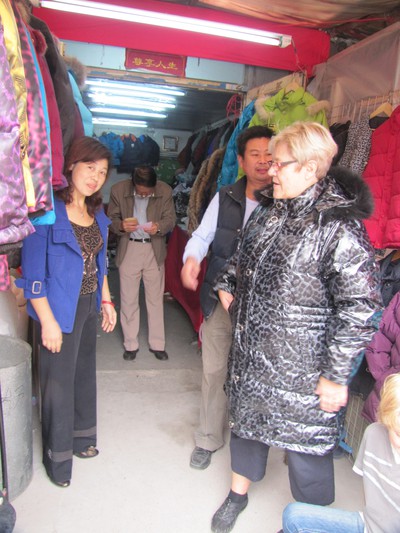

Hjalmar also got a jacket, but I did not manage to snap a photo.
They wanted to photograph Elsa together with the seamstress who apparently had made her jacket.

All the while, we had an audience in the market, who were commenting on how pretty both kids are. I guess it was a spectacle to watch large Scandinavians get down jackets at the local market, where one really does not see many, if any, Westerners.



Hjalmar also got a jacket, but I did not manage to snap a photo.
They wanted to photograph Elsa together with the seamstress who apparently had made her jacket.

All the while, we had an audience in the market, who were commenting on how pretty both kids are. I guess it was a spectacle to watch large Scandinavians get down jackets at the local market, where one really does not see many, if any, Westerners.

Beijing Zoo
We visited Beijing Zoo on Friday. A great day with a lot of animals. The kids had a lot of fun, to the degree that the grown-ups became exhausted. But it was fun to see so many animals. Most exciting was of course the giant pandas. None of us had seen any pandas in real life before.


Elsa asked particularly to see elephants. She got her wish.


She also wanted to see rhinoceri (or should that be rhinokeroi?).
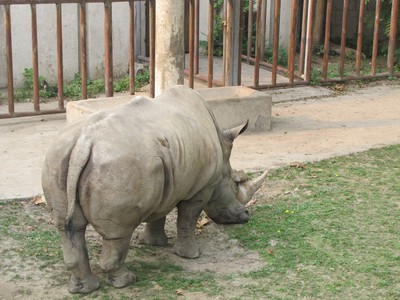
The tigers and lions were in cages, like in old-fashioned zoos.

The kids were fascinated by the hippopotamus.

Beijing Zoo is also an oldfashioned zoo in that they really try to have almost every kind of (big) animal. So we saw a lot of animals, and a lot that we did not photograph.




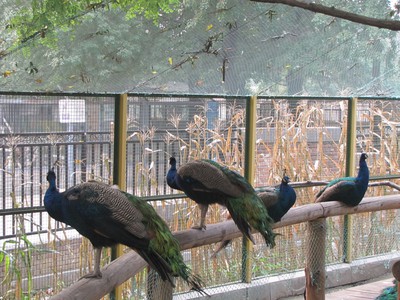

A nice feature in the zoo was a lot of sculptures of animals that kids liked to play on. Note the giraffes in the background!



As always, Elsa (in particular) attracted a lot of attention, and many asked to photograph her. Today she was sometimes tired of being photographed and said that she did not want to.

Some parts of the zoo is rather worn, while others are very pleasant, like this oasis behind the giraffes. It was not at all too crowded, despite it still being the National Day holiday, but we felt that we could move as we liked in peace and relative quiet. Recommended!



Elsa asked particularly to see elephants. She got her wish.


She also wanted to see rhinoceri (or should that be rhinokeroi?).

The tigers and lions were in cages, like in old-fashioned zoos.

The kids were fascinated by the hippopotamus.

Beijing Zoo is also an oldfashioned zoo in that they really try to have almost every kind of (big) animal. So we saw a lot of animals, and a lot that we did not photograph.






A nice feature in the zoo was a lot of sculptures of animals that kids liked to play on. Note the giraffes in the background!



As always, Elsa (in particular) attracted a lot of attention, and many asked to photograph her. Today she was sometimes tired of being photographed and said that she did not want to.

Some parts of the zoo is rather worn, while others are very pleasant, like this oasis behind the giraffes. It was not at all too crowded, despite it still being the National Day holiday, but we felt that we could move as we liked in peace and relative quiet. Recommended!

Jag idag 7 oktober
Efter anonyma klagomål bland kommentarerna på brist på JiD-bilder kommer här en från torsdagens utflykt till New Silk Market. This is me at my subway station. Note how clean the station is!


The Forbidden City
Wednesday, we visited the Forbidden City, the palace of the emperors of China. Outside the Tiananmen Gate, the famous portrait of Chairman Mao hangs, and we could not resist photographing the kids and my mother in front of it.

Grandma gave the kids a Chinese flag each.

Elsa wanted this kind of head adornment.

Which attractedt the paparazzi. Elsa smiled and was happy about the attention.

Later on, grandma got the pretty ornament, when the kids found new hats.

Hjalmar was particularly keen on his.

Two pictures of the palace.




Grandma gave the kids a Chinese flag each.

Elsa wanted this kind of head adornment.

Which attractedt the paparazzi. Elsa smiled and was happy about the attention.

Later on, grandma got the pretty ornament, when the kids found new hats.

Hjalmar was particularly keen on his.

Two pictures of the palace.



Back to Elsa's favorite restaurant
Ever since we first went to the restaurant where Elsa made immediate friends with, especially, one of the managers, Lili, she has wanted to go back. She has thrown temper tantrums when we did not go back, so we promised to go back yesterday. The same thing happened as previously: Lili and the other managers and waitresses spent a lot of time with Elsa until the food arrived. Elsa was happy. She got to borrow the princess crown again, and this time she got a hat on which it said "I love you." The food was just as good as before. Both children ate a lot.
This time, Hjalmar also got some attention, and he really liked that, I could tell.

This time, Hjalmar also got some attention, and he really liked that, I could tell.

Orange tree in the compound
On our way home, Elsa noticed that oranges were growing in a tree at one of the older houses in the compound where we live. There were also huge gourds.


Shopping Tuesday
Today we set out to find someone who could repair Hjalmar's Nintendo DS. The touch screen no longer works very well, so he has to borrow his sister's DS when he wants to play a game that requires the touch screen. We found two very pleasant young gentlemen in an electronic mall, who could help us with this. They also sold us a portable DVD player (for the kids), a UV filter (for my camera), various things for my mother, and a new stylus for Hjalmar's DS. The kids had fun, especially Elsa who played with one of the staff persons.
On our way to the store there were a lot of people.

Hjalmar and his beloved Nintendo DS. Now it has been fixed with a new touch screen.

Hjalmar really liked trying out a Nintendo Wii for too short a time.


On our way to the store there were a lot of people.

Hjalmar and his beloved Nintendo DS. Now it has been fixed with a new touch screen.

Hjalmar really liked trying out a Nintendo Wii for too short a time.


The Great Wall of China
On Monday, we visited the Great Wall of China at Mutianyu. This was a great experience. It took two and a half hour to go there in the car we had rented (with a driver); the Jiangcheng Expressway was rather crowded with cars, so it was relatively slow going. We got home in about two hours, so it was faster. Hjalmar thought it was OK interesting, but it took unnecesserarily long to get there. Mutianyu is not the place where the wall is closest to Beijing, so it was not very crowded.
The first photo is from the cable car up to the wall, which was at the top of a steep mountain. "How on earth did they get all the materials up there?" my mother wondered.


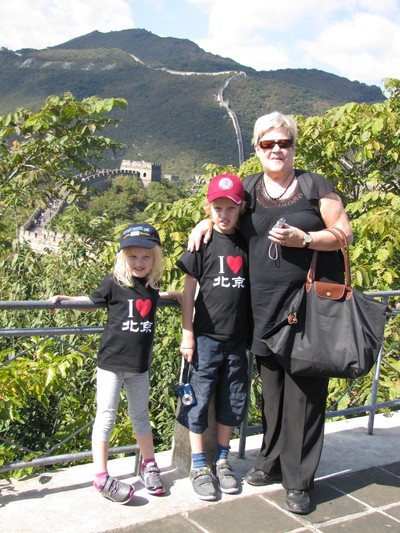



The first photo is from the cable car up to the wall, which was at the top of a steep mountain. "How on earth did they get all the materials up there?" my mother wondered.






Shopping Sunday
We have spent a long day in another market, getting a lot of things for Hjalmar and Elsa, and my mother got a lot for herself. I bought a pen and a belt.
Excursion on Peking University campus
On Saturday, we made an excursion on Peking University Campus. There were a lot of people there, who paid to get in, for this is a famous campus. With my professorial ID card, we were able to cut the line and get in for free (after I explained in Chinese that they are my children and my aged mother). We had a very pleasant walk in the most beautiful places on campus.
Hjalmar and Elsa by the Weiming Lake. Note the marble boat on the other shore.

Hjalmar and Elsa fed old bread to the fish from a bridge close to the West gate of campus.


A pillar from the emperor's old summer palace.

And a statue of Cervantes.

As always, people wanted to photograph the children together with their own children. Elsa is happy to model, while Hjalmar thinks it is "boring."

Hjalmar and Elsa by the Weiming Lake. Note the marble boat on the other shore.

Hjalmar and Elsa fed old bread to the fish from a bridge close to the West gate of campus.


A pillar from the emperor's old summer palace.

And a statue of Cervantes.

As always, people wanted to photograph the children together with their own children. Elsa is happy to model, while Hjalmar thinks it is "boring."

Excursion on Peking University campus
On Saturday, we made an excursion on Peking University Campus. There were a lot of people there, who paid to get in, for this is a famous campus. With my professorial ID card, we were able to cut the line and get in for free (after I explained in Chinese that they are my children and my aged mother). We had a very pleasant walk in the most beautiful places on campus.
Hjalmar and Elsa by the Weiming Lake. Note the marble boat on the other shore.

Hjalmar and Elsa fed old bread to the fish from a bridge close to the West gate of campus.


A pillar from the emperor's old summer palace.

And a statue of Cervantes.

As always, people wanted to photograph the children together with their own children. Elsa is happy to model, while Hjalmar thinks it is "boring." Actually, today two college students (from another university) wanted to be photographed together with me! That was unusual, but I think they used flattering me as a way of getting Elsa into the picture. They were very impressed that I teach at PKU, but did not seem to think Yale is particularly noteworthy.

Hjalmar and Elsa by the Weiming Lake. Note the marble boat on the other shore.

Hjalmar and Elsa fed old bread to the fish from a bridge close to the West gate of campus.


A pillar from the emperor's old summer palace.

And a statue of Cervantes.

As always, people wanted to photograph the children together with their own children. Elsa is happy to model, while Hjalmar thinks it is "boring." Actually, today two college students (from another university) wanted to be photographed together with me! That was unusual, but I think they used flattering me as a way of getting Elsa into the picture. They were very impressed that I teach at PKU, but did not seem to think Yale is particularly noteworthy.

Local market
On Friday, we went to a local market, where we bought dates, walnuts, and other nuts. The kids got equipment to make soap bubbles, and I and my mother bought a lot of tea.

Elsa learnt to drink tea in an elegant Chinese fashion in the tea store. She really likes tea.


Elsa learnt to drink tea in an elegant Chinese fashion in the tea store. She really likes tea.

Exercise inside the compound
Within the compound where I live, there is a small square. There are shops there, including the place from where I get my huge bottles of clean water. But there are also some exercise machines, that are meant for grown-ups, but the kids like them.




Master photographer Hjalmar shoots photo model Elsa
Hjalmar likes to snap photos and Elsa likes to pose.


Subway to grandma's shopping
On Thursday, we took the subway to the eastern parts of town so that grandma could do the shopping she has been craving.
In the subway of Beijing, children under 120 centimeters ride for free. Elsa measured in under 120, while Hjalmar, who is tall and handsome, got his own subway card
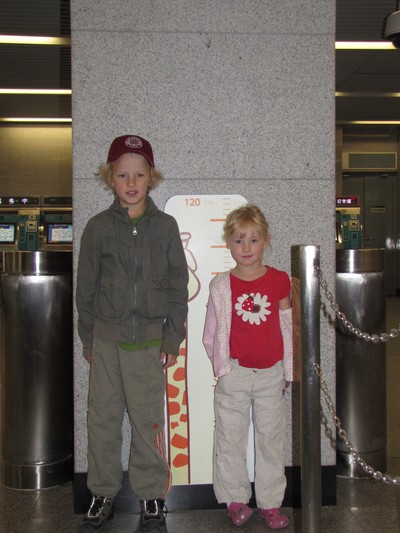
These Chinese toys were a hit, and could be used on the subway as well.

Elsa, grandma, and our friend Stella, who helped us to shop. Note how clean and pleasant the subway cars are!


The shopping team.

In the subway of Beijing, children under 120 centimeters ride for free. Elsa measured in under 120, while Hjalmar, who is tall and handsome, got his own subway card

These Chinese toys were a hit, and could be used on the subway as well.

Elsa, grandma, and our friend Stella, who helped us to shop. Note how clean and pleasant the subway cars are!


The shopping team.

